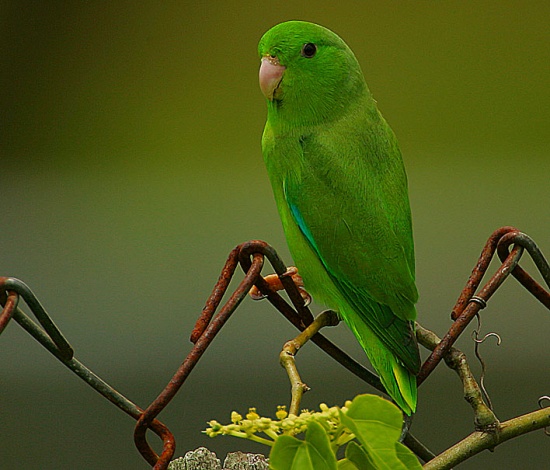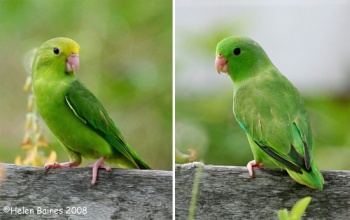- Forpus passerinus
Identification
12-13 cm (4.75-5 ins)
Generally green all over, nape and back of head has a greyish-white tinge. Lower back and upper tail-coverts nearest to base are green, in some birds with pale blue tinge; under wing-coverts and shoulders dark violet-blue; primary-coverts and base of secondaries violet-blue; outer webs of large upper wing-coverts pale blue. Tail yellowish green tipped with black. Bill pale horn-colour; narrow periophthalmic ring grey; iris dark brown; feet flesh-colored.
Female are like the males, but do not have the blue markings; narrow band to forehead pale yellowish.
Immature are like the adults.
Distribution
South America
Northern Colombia and Venezuela, the Guianas, northern and eastern Brazil, and Lower Amazonian Brazil.[1]
Taxonomy
Subspecies
There are 5 subspecies:[1]
- F. p. cyanochlorus (Schlegel, 1864) - The male is like the nominate race, but the female's tail feathers have more green on the underside, there is yellow throughout and a green forehead.
- Extreme northern Brazil (upper Rio Branco region of Roraima).
- F. p. cyanophanes (Todd, 1915) - On the male, the blue wing-markings are more violet and show more blue when the wing is closed.
- Arid, tropical, northern Colombia.
- F. p. deliciosus (Ridgway, 1888) - Smaller than the nominate race, the male has an emerald green rump with a bluish tinge and broad pale blue edging on the greater wing coverts. The female has more yellow throughout and a deeper yellow facial area.
- Eastern and lower Amazonian Brazil.
- F. p. passerinus (Linnaeus, 1758) - nominate race
- The Guianas.
- F. p. viridissimus (Lafresnaye, 1848) - It is like the nominate race but the male has paler blue markings.
Turquoise-winged Parrotlet has formerly been treated as a subspecies of this species.
Habitat
Inhabits lowland wet and dry forests, farms, ranches, gardens and city parks.
Behaviour
The parrotlets form small flocks flying quickly around and twittering, then they disappear into a tree in silence.
Diet
Their diet consists mostly of grass seeds.
Vocalisation
A constant twittering while at rest or feeding; flight call is a chee chee or chit-it chit-it.[1]
References
- Clements, J. F., T. S. Schulenberg, M. J. Iliff, S. M. Billerman, T. A. Fredericks, J. A. Gerbracht, D. Lepage, B. L. Sullivan, and C. L. Wood. 2021. The eBird/Clements checklist of Birds of the World: v2021. Downloaded from https://www.birds.cornell.edu/clementschecklist/download/
- Handbook of the Birds of the World Alive (retrieved December 2014)
Recommended Citation
- BirdForum Opus contributors. (2024) Green-rumped Parrotlet. In: BirdForum, the forum for wild birds and birding. Retrieved 29 April 2024 from https://www.birdforum.net/opus/Green-rumped_Parrotlet
External Links
GSearch checked for 2020 platform.1





